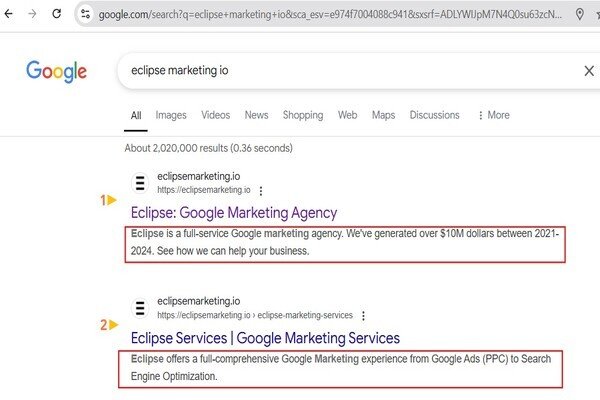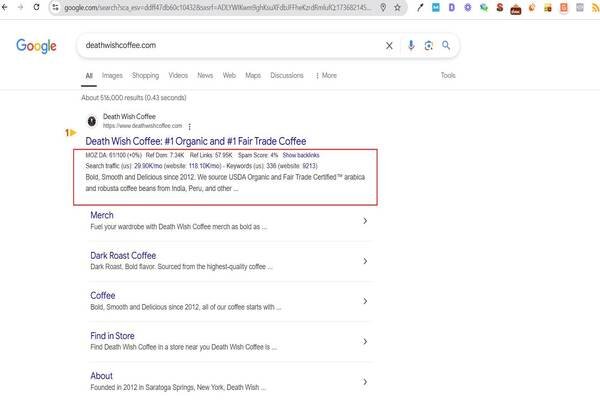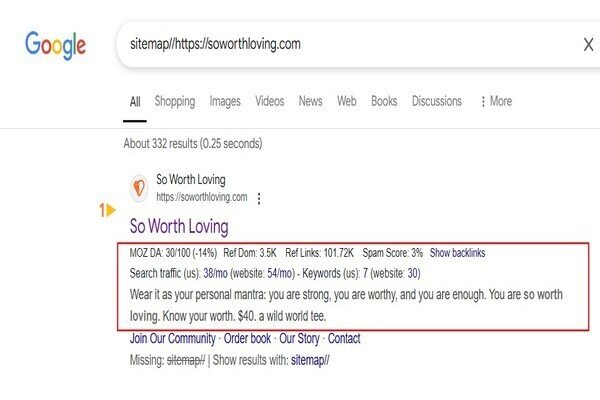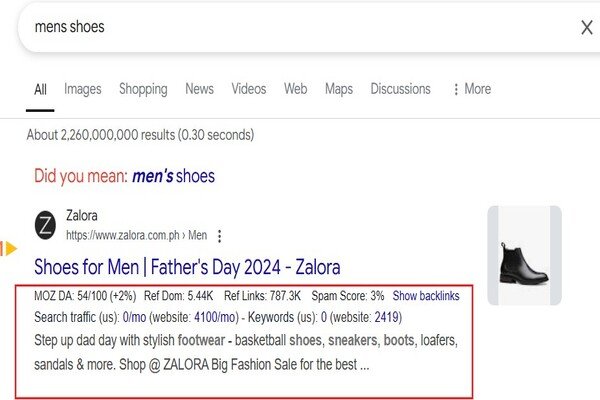How Do You Optimize The Website Meta Description?
You’ve been putting in the effort to market your business, fine-tuning your product descriptions, optimizing images, and tackling the core components of search engine optimization (SEO).
Yet, like many business owners, you might find yourself struggling with one critical aspect of e-commerce SEO: writing effective meta descriptions. In this guide, we’ll break down what meta descriptions are, provide actionable tips for crafting compelling ones, and explain how they play a crucial role in optimizing your site for search engines—making it easier for everyone to understand and implement.
What Are Meta Descriptions and Why Do They Matter?
A meta description is a short HTML element designed to summarize the content of a webpage. It typically consists of about 160 characters and appears as a snippet below your page title on search engine results pages (SERPs). This small but powerful piece of text helps users quickly understand what your webpage offers, encouraging them to click through. Well-written meta descriptions improve your website’s visibility and click-through rates by providing concise, relevant information that resonates with search intent. Optimizing meta descriptions is a crucial step in enhancing your website’s SEO performance and user engagement.

Why Meta Descriptions Matter for SEO Success
Search engines display meta descriptions in search results, especially when they include the keywords being searched.
While meta descriptions aren’t a direct ranking factor like page titles, they play a crucial role in convincing users to click through to a webpage, making them an essential part of effective on-page SEO. In the code, they appear as <meta name=”description” content=” a written description of the page”>.
Think of a meta description as your pitch to searchers. Amid a crowded field of web pages, it acts as your personal invitation, saying, “This is the page you’re looking for.”
For example, if you search for “temporary tattoos” on Google, the algorithm displays results on the search engine results page (SERP).
Although the SERP often includes shopping ads, images, and videos, traditional organic search results remain key, and your meta description can make all the difference. With a well-crafted meta description, your page can stand out and attract clicks, driving more traffic to your site.
The blue text you see at the top of search results is the “title tag,” which serves as the webpage’s title. Just below it, you’ll find a short description—called the meta description—limited to 155 characters. This brief summary plays a crucial role in increasing click-through rates on your webpage, which can indirectly influence your search rankings. It’s a small but essential part of optimizing your content for better visibility and engagement.
Is Google Rewriting Your Meta Descriptions?
Yes, Google often rewrites meta descriptions. But why should you invest time crafting unique ones if Google might display something different?
The key lies in the relationship between high-traffic keywords and lower rewrite rates. According to Kim Herrington, an experienced SEO and SEM consultant specializing in e-commerce, targeting high-volume keywords increases the likelihood of Google displaying your original meta description as intended.
Through her expertise, Kim highlights a practical approach for e-commerce businesses, where SEO can be both resource-intensive and complex: “When you target high-traffic keywords, your meta descriptions are more likely to remain intact on search engine results pages (SERPs).” This strategy helps save time and effort by focusing on what matters most.
Rather than creating meta descriptions for every single product, Kim advises focusing on your top-performing pages. “Put your energy into writing compelling meta descriptions for your bestsellers and category pages,” she says. These pages often drive the most organic traffic and deserve extra attention to improve click-through rates (CTR).
Take a closer look at your top 20 most visited pages. Ask yourself, “Are these pages effectively selling the product, or can I refine the meta descriptions to boost CTR?” A small adjustment could make a big difference in your search visibility and conversions.
By strategically prioritizing high-impact pages, you can maximize your SEO efforts while aligning with Google’s behavior.
Crafting Effective Meta Descriptions: Examples and Insights

Homepage
Reading meta-descriptions written by others can make the process seem deceptively simple, but achieving that level of clarity and brevity is surprisingly challenging. With a typical 160-character limit, meta descriptions need to be concise, often no more than a sentence or two.
A strong meta description gives a quick snapshot of what the page is about while providing an enticing reason to click on the title tag. The decision-making process happens so seamlessly that many users don’t even realize it—they just click, driven by curiosity and the promise of useful information.
Adding the right balance of keywords and appeal can make your meta description not only informative but also irresistible to your audience.

Product Page
Crafting meta descriptions for your product pages is simpler than tackling ones for your homepage. Why? Product pages don’t need to represent your entire business—they focus on showcasing the specific benefits of individual products.
- For example, if you’re selling spatulas, highlight how they simplify cooking tasks effortlessly. If you’re offering lawnmowers, paint a picture of a quick, seamless journey through the grass.
- Remember, a great meta description is your opportunity to connect with shoppers by clearly stating how your product improves their lives.
When looking for a compelling meta description, the search result for So Worth Loving stickers is a standout example. This meta description effectively highlights the brand’s positive message and unique product offerings, capturing attention while encouraging clicks. It uses concise, engaging language that resonates with the target audience, making the product even more appealing. This approach ensures that users immediately understand the value and vibe of what they’re exploring.
Crafting a meta description like this can significantly boost your click-through rate and connect with your audience on an emotional level.
“Wear it as your personal mantra: you are strong, you are worthy, and you are enough. You are so worth loving. Know your worth. $40. a wild world tee.”
This meta description uses a bold, motivational statement right from the start, instantly evoking feelings of empowerment and self-affirmation. It’s designed to capture attention by speaking directly to the reader’s emotions, encouraging them to see the product not just as an item of clothing, but as a personal mantra.
By capitalizing key phrases like “You are so worth loving,” the description creates an impactful statement that stands out. The boldness of the message, paired with the price point, is effective in appealing to shoppers looking for an emotional connection with a product, making it not just a purchase but an investment in their self-worth.
The description works to differentiate the product by focusing on its deeper value—more than just a tee, it’s a reminder of one’s inherent worth. It taps into the growing consumer desire for products that provide both style and personal significance.
The conclusion offers a clear, concise call to action with a price tag, giving readers the necessary information to make an informed decision without overwhelming them. This strategy drives curiosity about the product and its emotional benefits while ensuring that the price is front and center, suggesting that it’s both valuable and affordable.
In terms of SEO, this description uses emotional appeal and concise phrasing, making it ideal for both search engines and potential buyers. While not a complete sentence, it strategically leaves room for curiosity, making readers more likely to click and learn more.

Category Pages
When creating meta descriptions for your category or collection pages, it’s essential to focus on how they help organize related products for easy browsing. These pages often rank for high-volume, broad keywords, such as “women’s shoes” or “men’s sandals,” making them prime opportunities for optimization.
Your goal is to write a meta description that grabs attention and highlights key details about your product range. For example, DSW effectively lists various shoe styles within their women’s shoe category, providing valuable information that entices shoppers to click. By showcasing relevant information, you can help potential customers make quick decisions about exploring your collection.
It also incorporates straightforward, action-oriented phrases such as “Shop online for…” and “Enjoy a vast selection with free shipping…” These compelling calls to action are strategically designed to prompt users to take immediate action. By highlighting key benefits like convenience and shipping perks, these phrases make it easy for browsers to see what’s in it for them, increasing the likelihood of clicks and driving engagement with your website.
Blog Posts
Meta descriptions are short, powerful summaries that appear under your page title in search results. These 150-160 character blurbs should capture attention and motivate users to click on your link. To make an impact, focus on what makes your post unique—use action-driven language and naturally include relevant keywords. Even though meta descriptions don’t directly affect rankings, they can still significantly increase the chances of your content being clicked and viewed. Remember, a great meta description is your chance to hook readers before they even land on your page.

Social Media
Meta descriptions play a vital role not only in search engine optimization but also in your social media visibility. On platforms like Facebook, the text you provide in your meta description is what will appear when you share a link. If you don’t include a meta description, Facebook will automatically pull random text from your page, which might not be ideal for engaging your audience.
For example, in a Facebook post by Moz, a software company, the platform pulled the meta description directly from the URL of the page. This clearly shows the importance of having a well-crafted meta description, as it influences both search rankings and social media engagement.
Tips for Crafting an Effective Meta Description
Understanding meta-descriptions is just the beginning. Now, let’s explore how you can implement this knowledge for the best results.
- Understand the Customer’s Mindset
- Make It Unique
- Stick to the Optimal Length
- Make It Actionable
- Include a Clear Call to Action
- Incorporate Your Target Keyword
- Avoid Meta Description Generators
- Use Structured Data for Rich Snippets
- Test and Optimize
1. Understand the Customer’s Mindset
When crafting your title tag, it’s essential to keep two main questions in mind to entice potential customers to click:
- What are you offering?
- Why should I buy from you?
For product pages, the answer to the first question is straightforward: you’re offering your product. The second question is easily addressed by highlighting the fact that you’re the one providing the product, making your page the go-to destination for their needs.
2. Make It Unique
When writing your meta description, it’s crucial to clearly communicate what your business does, highlight your unique selling proposition (USP), and reinforce this message multiple times. The meta description is not the place for subtlety—it’s an opportunity to grab attention and boost clicks, so patience is key when refining it.
If you’re an established business, consider incorporating customer feedback to showcase why people return. If you’re just starting out, think about what makes your business stand out and why customers will be drawn to it.
Remember, the purpose of your meta description is not only to attract clicks but also to serve as a mini ad for your brand. As Stephen Light, CMO and co-owner of Nolah, says, “Meta descriptions are little ads, excellent for promoting your brand, even with character limits.” Crafting this description is similar to an elevator pitch—keep it concise, clear, and engaging. You may need a few drafts to get it right, but it’s worth the effort because this description will likely be your first impression with many potential customers. Also, avoid using the same meta description across multiple pages, as this can negatively impact your SEO.
3. Stick to the Optimal Length
When crafting your meta description, aim for a length between 155 and 160 characters to ensure it displays fully in search results. Google typically cuts off any text that exceeds this limit. Focus on placing your most essential keywords or action-driven phrases at the start of the description, followed by a brief mention of your brand. This approach helps grab attention and boost your click-through rate.
4. Make It Actionable
Meta descriptions act as the welcome mat to your eCommerce site. They should be clear, engaging, and encourage action. Let visitors know exactly what they can expect when they click through.
Avoid overloading your description with excessive adjectives or complex words—terms like “amazing” or “incredible” may sound appealing, but they can make your description less compelling. Instead, aim for an active voice that grabs attention and drives action. If you decide to add a touch of creativity, ensure it’s relevant to the content on the page.
5. Include a Clear Call to Action
Incorporating a call to action (CTA) in your meta description is an effective way to drive more clicks to your page. A well-crafted CTA informs potential customers about what they’ll find and what actions they should take next. For e-commerce stores, it’s crucial to align your CTA with the motivations behind a customer’s search.
When a user searches with a broad term like “women’s shoes,” category pages are often the top results. People typically browse through these pages before deciding on specific products, while product pages are designed for final purchases. Reflecting this browsing intention in your CTA can help you connect with users more effectively.
For e-commerce sites, here are some CTA examples that drive engagement:
- Shop Now
- Explore the Collection
- Discover New Trends
- Browse Our Products
6. Incorporate Your Target Keyword
To improve your website’s ranking, it’s essential to incorporate your target keywords effectively. But don’t fall into the trap of overstuffing them into your content in a way that feels unnatural. For instance, using a meta description like “Buy Women’s Shoes, Women’s Tennis Shoes, and Women’s Shoes on Sale here!” might seem like a good idea, but it ends up sounding robotic and unappealing to both your audience and search engines. Instead, aim for a balance where your keywords fit naturally into the text, making it both human-friendly and SEO-optimized. This will help your page rank higher while maintaining a professional and approachable tone.
7. Avoid Meta Description Generators
There’s an ongoing debate over whether or not using generators to write meta descriptions is a good idea. While automated tools can produce quick descriptions, they often lack personality and can feel uninspired. This can be a practical option for large brands with numerous SKUs and limited resources to manually craft descriptions.
However, for small businesses, it’s usually best to write meta descriptions by hand, especially for high-traffic pages. Melanie Bedwell, e-commerce manager at Olipop, a popular drink brand, supports this approach.
“Meta descriptions should be unique,” she emphasizes. “It’s much easier to make them stand out when you have someone on your team writing them. The meta description is a prime opportunity to grab someone’s attention and encourage them to click. I believe it’s too important to leave to an automated generator.”
The rise of automated tools has led to Google stepping in to rewrite descriptions. The search engine aims to avoid low-quality, boilerplate content that doesn’t align with search intent. In fact, some argue that it’s better to leave a page without a description than to use a poorly written one created by automation.
8. Use Structured Data for Rich Snippets
Structured data enhances your website’s appearance in search engine results by adding special code to your web pages. This code helps search engines understand the content more clearly, providing key details such as the type of information on your page.
When structured data is implemented correctly, search engines can display enriched results known as rich snippets. These enhanced listings might include additional details like product ratings, prices, or event dates, directly in the search results.
Rich snippets grab attention and are more likely to lead to clicks on your website. By integrating structured data, you improve your site’s chances of standing out in search results and attracting more visitors.
9. Test and Optimize
Testing your meta descriptions is essential for finding out which ones drive the most traffic to your website. Think of it as running experiments to see which version grabs the attention of your audience. By creating multiple versions of meta descriptions for the same page, you can compare their effectiveness.
To test, utilize tools like Google Search Console, which reveals how many clicks your search result receives. These tools also provide insights into how your page ranks in search results. Experiment with various styles, lengths, and types of information in your meta descriptions. Then, observe how these changes impact your clicks and rankings.
Create Your Own Effective Meta Descriptions
Whether you’re new to running an online store or you’re an experienced eCommerce professional, crafting compelling meta descriptions is key to boosting website traffic, enhancing user experience, and improving conversion rates. By following these essential steps, you’ll be on track to optimizing your web pages and reaping the rewards of increased traffic and higher sales.
Conclusion
In conclusion, optimizing meta descriptions is a crucial element of effective SEO for eCommerce sites. By creating compelling, clear, and action-oriented meta descriptions, you can improve click-through rates, enhance user experience, and drive more organic traffic to your pages. Remember to focus on high-impact pages, use relevant keywords, and write unique descriptions for each product or category. Regular testing and adjustments can further refine your strategy, ensuring long-term SEO success. Ultimately, well-crafted meta descriptions help attract the right audience, increase engagement, and contribute to higher sales and better online visibility.
FAQ’s
- What is the ideal length for a meta description?
Aim for a meta description length between 155 and 160 characters to ensure it displays fully in search engine results without getting cut off. - Do meta descriptions impact SEO rankings directly?
Meta descriptions don’t directly impact SEO rankings, but they help improve click-through rates, which can influence your website’s performance in search results. - Can Google rewrite my meta description?
Yes, Google can rewrite your meta description if it doesn’t align well with the search query. However, using targeted keywords and creating compelling descriptions can minimize the chances of this happening. - How can I make my meta description stand out?
Write clear, concise, and action-oriented meta descriptions. Use engaging language, highlight your unique selling points, and include a strong call to action to drive clicks. - Should I use a meta-description generator?
It’s better to write your own meta descriptions. Custom, well-crafted descriptions reflect your brand’s voice and engage your audience, improving click-through rates.
Users Also Say
User1:Calis*****
When I search for an answer or a definition, I find it frustrating when the meta description doesn’t directly match the information I’m looking for. I’m not a fan of overly fluffy meta descriptions, but that’s just my personal preference. I also don’t rely on Google’s auto-suggest keywords because they’re too broad and may not align with my content.
Here’s how I approach it:
- I build my page content with relevant keywords, considering competitors’ keywords, search volume, and more. This makes it easier to include these keywords in the meta description.
- I pay attention to the length—keeping it under 155 characters so it displays fully in the SERPs.
- I aim for specificity and use an active voice.
- I always include a call to action.
- I make sure the meta description stays relevant to the page it’s linking to.
User2: npm***
The first sentence of your page should naturally describe its content, setting the tone and providing a clear overview. It acts as an introduction, ensuring that visitors immediately understand the page’s purpose and relevance, encouraging them to continue reading and engage with the rest of the content.
User3: sash****
I believe a meta description should be written as a short abstract, a brief synopsis, or even as questions or a short paragraph that’s specific and relevant to the content. Writing an effective meta description starts with understanding the content itself and using targeted keywords that align with your EAT (Expertise, Authoritativeness, Trustworthiness).
While meta descriptions left blank may still appear on SERPs (using relevant content from the page), the results are not guaranteed. Google’s algorithms determine what content is most relevant to a user’s query, which can be unpredictable.
Even if you craft a meta description, there’s no assurance it will appear as written because meta descriptions adapt to the user’s query, context, and specific keywords. Ultimately, it comes down to personal preference. Some people leave it blank, while others choose to write meta descriptions using targeted keywords to drive higher CTR in the SERPs.
